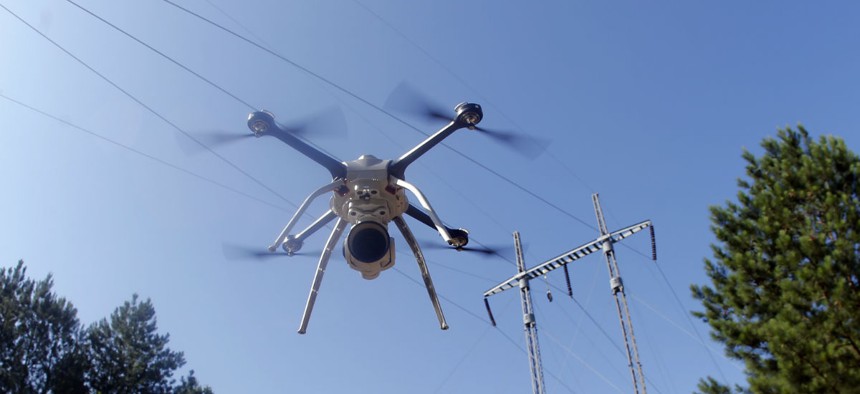The Government Is Testing Military-Grade Technology to Keep Drones Away From Airports

John Bazemore/AP
With the agency’s final rule for commercial drones still more than half a year out, FAA is responding to an increasing number of “close calls” between airliners and drones.
The Federal Aviation Administration is testing military-grade technology to keep commercial and personal drones in the U.S. from getting near airports and other sensitive airspace.
The FAA is teaming up with CACI International—a federal IT, intelligence, and military contractor—to test “technology that identifies unmanned aircraft near airports,” the agency’s deputy administrator, Michael Whitaker, announced at a Wednesday congressional hearing.
Lawmakers on the House Transportation Committee’s Aviation Subcommittee expressed alarm at the rapidly rising numbers of drone sightings by commercial pilots, and called on the FAA to take action to prevent a potentially catastrophic collision between a drone and an airliner.
Whitaker said his agency gets about 100 reports a month of drone sightings near airplanes and airports.
The FAA’s partnership with CACI is the latest in a series of escalating moves to try to keep drones from accessing restricted airspace. The FAA’s least intrusive strategy is an education campaign: Through programs called “Know Before You Fly” and “No-Drone Zones,” the agency is trying to raise awareness about where hobbyists and commercial drone operators are not allowed to go.
Some members of Congress have pushed the FAA to go further in restricting access to certain airspace, asking the agency to create mandatory geofences that would prevent drones from being flown where they shouldn’t be. Sen. Chuck Schumer intends to introduce legislation to set up virtual fences around sensitive areas. Software baked into drones would keep them from entering the fenced-off areas.
But Schumer’s plan, which is backed by Rep. Adam Schiff in the House, is far from foolproof, because geofencing software in drones is easily modified and disabled by a savvy user.
The CACI technology that the FAA is now testing has different capabilities, and, by one account, goes even further than geofencing in its invasiveness.
The CACI technology can “passively detect, identify, and track UAS—or aerial drones—and their ground-based operators,” said John Mengucci, COO and president of U.S. operations for CACI, in a statement.
The technology would be a valuable tool to the agency, one of whose “biggest challenges,” Whitaker said, is locating operators who are flying drones where they should not be.
According to Rep. Peter DeFazio, however, the technology is able to do more than just detect and track drones.
“It’s been used in military applications. As they explained it to me, they can pinpoint the operator—that’s good. They can do numerous things: They can force the drone to land, they can force it to go back to the operator, or, in the case of hostiles, they deliver something to the operator,” DeFazio said at the Wednesday hearing.
DeFazio went on to describe a scenario that he said the technology would enable.
“You wouldn’t want to necessarily disable them and have them drop out of the sky, but they can also direct them to another place, and if we had designated safe sites around airports or critical airspace and we used this technology, we could direct the drones there and say, ‘Oh, come get your drone, we’ll be waiting,’” the Oregon Democrat said.
A CACI representative did not respond to multiple requests for comment.
Lawmakers on the House panel pressed Whitaker for other ways to make an increasingly crowded national airspace safer.
The FAA’s rules for small commercial aircraft, which were due last month, have still not been finalized. Whitaker said his best estimate for when the rule will be complete is June 17, 2016.
“I’m disappointed,” said Rep. John Mica, who pressed Whitaker on the timing of the final rule. If guidance is not issued soon, Mica predicted, there will be a “very serious accident.”
“There are just so many of these now flying that it’s almost inevitable that we have a drone hit an aircraft, and there will be probably injuries and hopefully not fatalities,” he said.
In the meantime, DeFazio and Rep. Rick Larsen, a Democrat from Washington, recommended the agency create a registry for drone operators.
Whitaker said his agency is considering keeping such a database, but he warned that the volume of data might be too much for his agency.
To illustrate the necessity of registering drones, Larsen reached for an example from his home state’s prominent crabbing industry.
“You’ve got to put your name and address and contact info on your crab pot buoy, in case it gets loose or in case someone steals it,” Larsen said. “But you have to do this because you need to be held accountable, and so it’s the same kind of deal.”
“You could have drones monitor the crab pots,” offered Subcommittee Chairman Frank LoBiondo.



